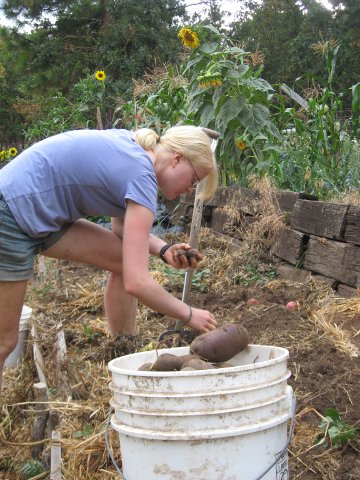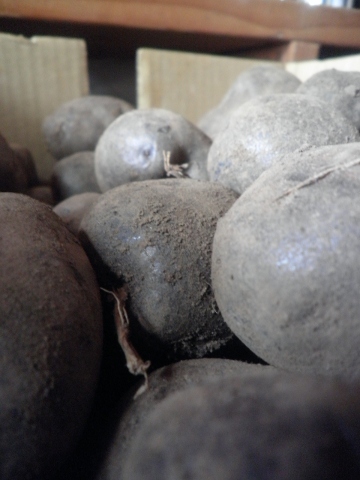Potato Harvest
Lindsay:
The potato harvest always seems to mark an important transition here on the plateau. While it is certainly true that the only thing that is constant here is change, there are periods of transition that make their presence well known. As the summer light leaves us and Orion wanders his way into the night sky, our rhythms simultaneously slow in pace and increase in intensity.
Our outdoor work days are shorter but the windows for harvesting foods for the winter are often short also, and the time we have to put away firewood before the fall rain comes is nearing its end. There are certain activities that need to happen at their due time and these few weeks in the beginning of fall when we dance between frosty nights and soaking rains are deceivingly full of tasks needing to be checked off the list.
Sarah harvesting potatoes
 |
| |
While potatoes often finish maturing by then end of July, perhaps the best place to store them through the summer heat is in the ground. Since the summer soil is so dry, there is little danger of having the potatoes rot. However, we do not want the potatoes in the ground once the rains begin.
And since the garlic is being planted where the potatoes were this past season, we needed to harvest the potatoes and transfer them to winter storage. So harvest we did: red, white and blue potatoes. I am pleased that the fingerlings and the all blue potatoes, two new varieties added to our garden this year, faired quite well and produced abundantly.
fingerlings
 |
| |
Interestingly, one row, which contained all the varieties, yielded as much as the two other rows (also planted in all the varieties). There was nothing substantially different about the preparation or watering of theses rows, so the discrepancy in yield is intriguing.
The only notable difference was that 1/4 or so of the potato row that had higher yields was planted directly next to peas, and the plants were noticably larger in size than the plants not growing near the peas. So, next year I plan to plant peas along the entire bed of potatoes to see if we have a similarly beneficial result.
all-blue potatoes
 |
| |
Not too long after the potatoes were harvested, we started preparing for planting garlic. Garlic, like potoatoes, is a crop that is well matched to our moisture regime here on the plateau. Garlic is planted in the fall and stays relatively dormant through the winter and then grows through the spring and into the early summer, with harvest usually in mid July. So garlic gets most of its growing done while we have plenty of precipitation and then just as the soil is drying out, it is time for the garlic harvest.
Partly because it grows so well here, and partly because we just love garlic, we are increasing our garlic production and to do so we are starting four new varieties. Susanville, Transylvanian and Early Italian Red are all soft-neck varieties which are better for braiding, while Chesnok Red is a hard-neck which produces delicious scapes in early summer.
And finally, in order to make room for the mushroom bed (described in an earlier article) and to allow enough time for the spawn to grow before the winter cold settles in, we needed to harvest the sunchokes. Sunchokes, or Jerusulum artichokes, are an unusual tuber in the Sunflower family that functions as a perennial. We received our first batch from a neighbor, but the sheep can stick their heads through the fence and reach the snack on the stems where they were initially planted.
Eliot harvesting sunchokes
 |
| |
So, we started a new sunchoke patch early this past spring by digging up the tubers and transplanting them. Apparently, however, a few were missed and so Eliot was able to harvest 10 pounds of volunteer sunchokes the other day in preparation for the mushroom bed. They have a unique flavor and can be used in soups and stews or even eaten raw, and are a great alternative to potatoes.
In some climates they can become invasive, however we have a low risk of this happening because it is unlikely they will be able to grow prolifically without additional water through our droughty summers.
Notes From Windward - Index - Vol. 70
|
|